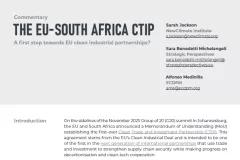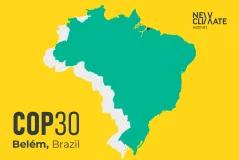A joint blog by NewClimate Institute, Germanwatch, E3G, and NRDC by Hanna Fekete, Imogen Outlaw, Santiago Woollands, Anja Gebel, Laura Sabogal, Erin Landy, and Jake Schmidt
Following the release of their “Instrument Methods” for Paris alignment, the World Bank Group published accompanying sector notes for Energy and Extractives; Agriculture and Food; Transport; Environment, Natural Resources and Blue Economy; Water; as well as Urban, Resilience, Disaster Risk Management, and Land. The notes detail the approach to assess whether different types of projects in these sectors are aligned with the Paris Agreement. The World Bank Group will update the notes, and will publish six more for additional sectors. In this blog we look at whether the approaches in the notes are sufficient to avoid financial flows that conflict with the Paris Agreement.
Our analysis shows a mixed picture, where the approaches for some project types complement and provide more clarity and detail to the general instrument methods. The sector notes include a few particularly positive features, like a comprehensive approach in terms of project type coverage and a promising approach to lock-in risk assessments, particularly for but not limited to the power sector.
Still the notes leave room for improvements. For some critical project types, for example technical assistance for oil and gas, the level of detail seems rather low. And the risk assessments could be undermined by too much freedom for staff conducting the assessment, for example the choice of analytical model and data sources and the option to focus on an asset-level assessment rather than assessing the project in its context and other projects in the pipeline. In other cases, guidance promotes the adoption of low-carbon alternatives without referencing the threshold for low carbon or clarifying how this is assessed.
A consideration of the detailed elements that the sector notes provide can spur thinking about different projects and countries’ transitions in the context of a global decarbonisation. However, the notes alone will not prevent the projects that could conflict with the Paris Agreement to be filtered out.
Here are a few concerns about the sector notes and Paris alignment:
Too much room for oil and gas. The World Bank Group decided in 2017 to no longer provide direct finance to upstream oil and gas after 2019. Civil society groups have criticised that this promise has been broken various times. It is disappointing that the sector notes explicitly allow technical assistance for upstream oil and gas projects under certain circumstances. The sector notes also allow fossil fuel transport infrastructure, as long as it can be repurposed, including blends between fossils and synthetic green fuels. The question of repurposing and blending comes with many uncertainties given that green gases will fill a niche in a decarbonised energy sector, and should not be used as an argument to build up infrastructure for fossil fuels.
Reliance on NDCs, LTSs and CCDRs. Like the overarching Paris alignment methodology, the sector notes require the projects to be in line with countries’ climate targets, which in aggregate are insufficient to limit temperature increase to the agreed levels and often lack sufficient detail to guide investment decisions, risking future carbon lock-in and stranded assets. The sector notes require assessments for some project types to consider Country Climate and Development Reports (CCDRs), but allow flexibility in how the diagnostics are applied in the Paris alignment assessment of operations, and the CCDRs themselves would benefit from more standardisation across countries to ensure a high level of quality. And so far, there are only 25 CCDRs and it will take a while to comprehensively cover most countries. World Bank Group does not publicize the comprehensive data or modelling that is behind the CCDRs, so the Paris-compatibility of those recommendations is also hard to follow. Provided the issues around standardisation and transparency of data are remedied, the CCDRs are a potentially standard-setting vehicle if they are based upon 1.5°C aligned strategies. For the land sector, previous analysis from NewClimate found that CCDRs are “a lost opportunity” because they generally lack a clear vision of a Paris aligned land sector, especially when it comes to livestock emissions.
Reiteration of the universally aligned list. Like the instrument methods, the sector notes state that specific categories of projects under each sector are exempt from the Paris alignment assessments since they are listed as universally Paris-aligned on the joint MDB list. However, many of those activities would merit scrutiny with regards to Paris alignment, either because their climate risks might not always be negligible (e.g., port infrastructure, aquaculture), or because they could benefit from an alternatives assessment to identify the most climate-positive design and maximize their transformative impact (e.g., public services, water supply systems).
Focus on risk mitigation, neglect of opportunities for climate action. Similar to the instrument methods, the sector notes focus predominantly on providing support for the identification of potential climate risks in operations, i.e. on doing no harm to the Paris climate change mitigation goals. The sector notes go into quite a lot of detail on different sub-categories of investments to outline potential risks; yet, they fail to list potential climate-positive measures or provide guidance on how to design operations in a way that mainstreams opportunities for green development or how to identify the most climate-positive alternative. This focus on risk mitigation, however, neglects the fact that achieving the Paris goals urgently requires transformative action.
Enhancement of resilience through the investment is not considered. While the sector notes include considerations of resilience and adaptation risks that could arise for investments (i.e. the problems that climate change could cause for the investments), they do not consider negative systemic impacts on climate vulnerability that might arise from the investment (e.g., from an agricultural project that relies on irrigation, potentially worsening water scarcity in a region hit by drought). Nor do they provide guidance on potential measures to increase a country’s resilience to climate change in that sector through the investment, e.g. by identifying opportunities for investments to deliver broader resilience benefits. For instance, infrastructure could be designed to build community resilience by reducing the vulnerability of exposed populations, enhancing livelihoods and protecting assets.
Most methods leave room for interpretation. While some flexibility is essential to cover different contexts meaningfully, we find that the sector notes leave a high degree of freedom for the project officers to set parameters of the analysis, thus allowing for a range of different outcomes. A lack of transparency on selected analytical models and data increases the risk that unaligned projects slip through. In addition to a risk of mis-alignment with temperature limits, a lack of guidance can be a burden for project officers, leading to inconsistent outcomes for similar projects and failing to provide indications for future projects to be developed. For agriculture and food, for example, we find that the impact of this guidance will hinge on how stringent the definition of climate smart agriculture is. The energy and extractives note, for example, describes feasibility as “technically feasible and economically viable”, but the fast and comprehensive transitions that are required will often have to go beyond what is typically considered economically viable by the banks, and depending on the counterfactuals chosen, project officers are likely able to drive the outcome of the analysis to a large extent.
Positive elements we found include:
The World Bank’s approaches highlight the positive development impacts of Paris alignment beyond climate change. The sector notes show examples of how a closer look at implications around the Paris Agreement does not only foster mitigation, adaption and resilience, but also additional development benefits. A good example is the transport sector, where the approach for road infrastructure projects requires a qualitative assessment of how the project can be designed so that it also promotes public and non-motorised traffic. This makes roads safer and more accessible also to people without their own private vehicle. A checklist on what options to consider could even further enhance this approach (see previous analysis of Germanwatch & NewClimate, table 13). The energy note includes considerations on a just transition in the power sector, with the objective to “retain workers for new areas of employments and strengthening social protection” after the closure of coal mines of power plants. This best practice approach should be applied across all operations involving the phase out of other fossil fuels.
A potentially promising approach to lock-in risk assessment for the power sector. For the power sector, i.e. mainly fossil gas power plants, the risk assessment includes consideration of feasible lower-GHG emissions alternatives, whether the operation could prevent or slow down the transition to lower-carbon alternatives and the operation’s economic viability in the face of the energy transition (“stranded asset assessment”). This is a comprehensive and forward-looking set of considerations, which, if applied thoroughly, will prevent non-aligned investments in the power sector. However, as explained above, there is room for interpretation in the methods, potentially threatening the overall strong framework.
Relatively-comprehensive coverage of what will be assessed. The sector notes include direct investments as well as technical assistance and policy-based lending. Lending through financial intermediaries is somewhat awkwardly grouped in with “investment project financing” and would benefit from more detail and its own instrument method1. While the notes say that projects with a high level of direct emissions will require higher scrutiny, they also include projects with low emissions. This would identify projects for example for infrastructure that do not emit greenhouse gases themselves, but could cause indirect emissions elsewhere or prevent or slow-down the transition. In the Agriculture and Food note we find a good overview of potential risks of development policy finance on land sector emissions, feasibility studies, technical assistance and other measures that insinuate other interesting solutions to decreasing emissions from the sector and remove barriers, although more details and examples are missing. Additionally, the notes cover development policy financing – support for governments to improve service delivery, strengthen planning frameworks, and implement regulation – which includes consideration of policies’ impact on GHG emissions and potential for future carbon lock-in, particularly for urban planning and the building sector.
An integrated perspective on climate across instruments and sectors. In some cases, the notes seek to provide an integrated perspective on how different financing or technical instruments can work together to address climate-related risks or challenges hindering the deployment of low GHG alternatives. This is the case for the agriculture and food sector note which mentions that relevant measures to mitigate lock-in risk for investment operations might include elaborating climate-informed national plans for sub-sector development – something that could be supported through development policy operations and/or technical assistance. However, this is not alluded to in other key sectors such as energy.
The notes also explicitly consider how to leverage potential GHG wins across different sectors. This is important because an integrated approach can enhance overall consistency and effectiveness of operations, in terms of both climate and development impact.
On its website, World Bank does not describe the process or timeline for updating the notes or instrument methods, but provides contact details for feedback to the bank, indicating the possibility of future revisions of the methods.
To strengthen the framework for Paris alignment in the context of the sector notes, World Bank could:
Emphasise the mutual benefits between climate change mitigation, adaptation and other development goals. We found links to win-win effects between development priorities and climate action in some sector notes, but a more comprehensive approach to integrate the positive impact of climate action on SDGs in the notes would help to harvest the synergies, foster the inclusion of climate-transformative measures in projects, and make the framework more attractive to developing client countries.
Continue capacity building of staff and advance analytical approaches. The World Bank is already considerably investing in building internal capacities, e.g., by training staff on Paris alignment. These efforts need to continue across the WBG including staff based in country offices. Furthermore, climate diagnostics, i.e. the application of the sector notes and related analysis, need to be regularly conducted and mainstreamed into projects, and the early and systematic involvement of staff in the climate division needs to be improved, e.g., by creating respective internal accountability mechanisms. Finally, as technological development is a dynamic process, it is important that the results framework of projects include a monitoring & evaluation (M&E) mechanism which allows for learning at the country and programmatic levels. This will strengthen the robustness of the assessment process performed by staff across the Bank guided by the sector notes.
Publish as much data and analysis on Paris alignment project assessments as possible: Transparency will allow others to understand the rationale of the approach, increase scrutiny of the assessments and hence enable accountability. It will also provide a structure to interact with civil society in a meaningful way and discuss concrete problems in order to continue improving the bank’s Paris alignment approach.







